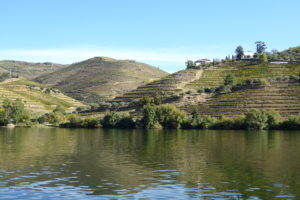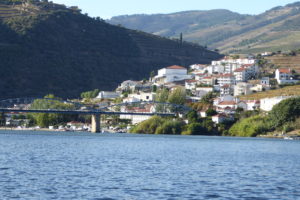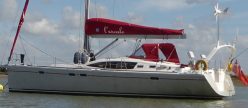Tuesday 1 – Sunday 6 October
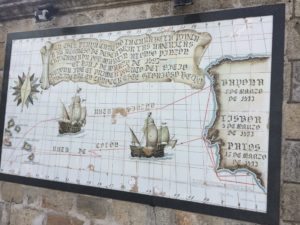
commemorating the voyage of the Pinta,
discoverer of the New World
On Tuesday morning we manoeuvred over onto an outer hammerhead at Bayona marina, to rinse off the salt and grime of Vigo and refill our water tanks. An unsightly heap of someone else’s unwanted detritus greeted us on a scruffy pontoon, nobody responded to our radio call to request permission to dock, and when we made our way up to the marina office, nobody was on duty. We made a quick sortie around the town to track down some provisions and take in the sights, and when we returned to the marina, the guy in the office apparently couldn’t be bothered with the paperwork, and said as long as we were leaving straightaway there was no charge. We must have omitted to mention that we’d helped ourselves to water.
We were soon back and settled in the anchorage for our last night in Spain. Mate was a little disappointed not to have had the opportunity to explore the Islas Cies, the fourth, final and Southernmost of the National Parks, but was comforted with the observation that they looked a lot higher than Isla Ons, and would have presented more challenging walking.
The following morning we were up and away at first light: 0800, and at noon ship’s time we’d reached the border with Portugal, all under motor as there was no wind at all. The Rio Miño (Spanish) or Minho (Portuguese) forms a natural frontier, and is guarded at its mouth on the Spanish side by a very distinctive conical hill, visible for miles once passed heading South. As the afternoon breeze began to fill in, we were able to run under the gennaker, until the wind strengthened to NW 4-5, and we continued under genoa only.
As the city skyline gradually clarified in the afternoon haze, at teatime we were five miles from Póvoa de Varzim (pronounced something like Povwad Varzim), and we gybed to make the entrance, before furling the foresail and motoring around the Western breakwater and into the harbour. We dropped anchor as indicated by the pilot book, between the fishing harbour and the marina pontoons, having sailed 54 Miles in around eleven hours.
That evening we adjusted the ship’s clock to Portuguese time, back an hour and corresponding with UK hours.
The following day we felt an unpleasant grating as we touched an uncharted rock at Low Water, so we reanchored before going ashore to explore. Entering the marina office to register our arrival, which we’d been led to believe must be done immediately on making landfall, we were advised that “the books are wrong” and yachts are NOT allowed to anchor in most Portuguese harbours, except with special permission from the relevant authorities. We apologised, and arranged to move into an assigned berth in the marina on our return from town later in the afternoon.
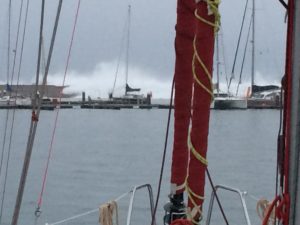
Having looked at the proposed berth, we weren’t enthusiastic about moving as boats already tied up were lurching and snatching at their lines, while l’Escale was lying calm and stable in the harbour. When we returned, it was approaching High Water, it was Springs (highest and lowest tides in the bi-monthly cycle), and a large swell was running – straight at the harbour wall, and crashing over the top to pour into the marina, causing even more and violent movement. One of the pontoon fingers had collapsed, with a yacht still attached to it, and staff were doing their best to mitigate damage. They were quite happy to allow us to stay in the harbour, and the marina manager later confirmed that he’d received authorisation from the maritime police that we could remain there.
The French skipper of yacht Millennium that we’d met in A Coruña had recommended a selection of stops, and especially Póvoa de Varzim as a cheaper alternative to Porto, reachable by metro in an hour. As it turned out, it was a free stopover, and we enjoyed visiting the beautiful old town of Porto at the mouth of the River Douro, home of port wine. The mini self-guided walking tour of Porto that Mate put together from information on the Internet is on the ‘Tourist Tracks’ page.

On Sunday we made an early start to take the metro down to Porto again, this time to catch a train for a two-hour ride up the Douro valley to Pinhão (say Pinyow as in owl), where we enjoyed an alfresco lunch on a vine-shaded terrace overlooking the river, before meeting a traditional rabelo boat for a two-hour cruise up to the Tao dam and back. The sun shone, Mate spotted a kingfisher racing along the riverbank and the scenery was stunning. A fitting, if delayed, celebration of our wedding anniversary.
